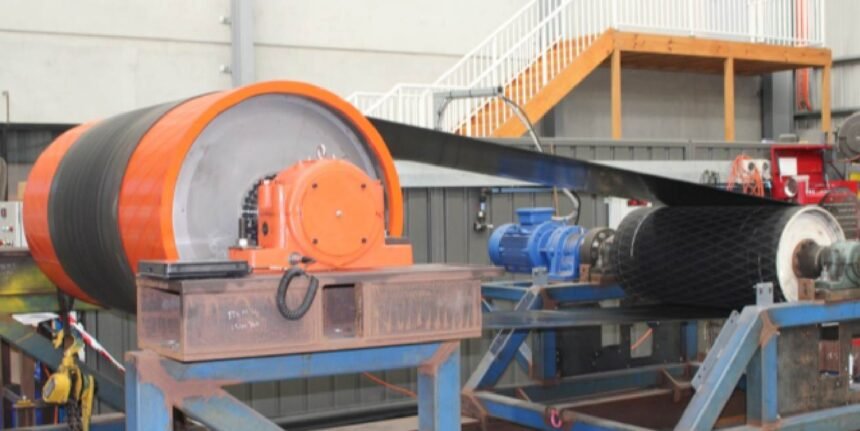It is much easier to simply explain that in the world of conveyor systems, numerous various components collaborate to ensure that effective movement of materials is maintained. The snub pulley is one of the most important but least noted components. Though it is not as widely known as the drive or head pulley, a snub pulley is a critical part of the overall performance of a conveyor belt.
This article describes a snub pulley, how this pulley works, and the importance of the pulley in a material handling system.
Snub Pulley definition
Snub pulley refers to a small pulley attached to or close to the drive pulley of a conveyor system. Its sole aim is to make the area of contact between the belt and the drive pulley enlarged. This additional touching aids in increasing the traction of belts, lowers the slippage of belts, and assists in maintaining belt tensions.
It does not control the belt directly and does not carry any loads. Rather, it helps the drive system by gaining better grip and stability.
Where is a snub pulley located?
The pulley, which has been snubbed, is normally located:
- The conveyor belt went round the other side of the ship.
- Close to the drive pulley
- It is placed in such a way as to deflect the belt at a small angle.
- By being in the place, it can steer the belt beneath the drive pulley, and this causes the angle at which the belt meets the drive pulley to be shifted upwards.
- It names the angle the arc of contact.
Working Principle of Snub Pulley
The belts are used in the form of a snub pulley, which is used in the direction of the belt, which changes the direction of the belt slightly before or after contact on the drive pulley. This modification extends the arc of contact by increasing it, and this implies that the belt encompasses a greater area of the drive pulley.
A bigger wrapping surface will imply:
- Greater contact on the belt and pulley
- Slippery is less likely to occur
- Improved regulation of the movement on the belt
- Although the snub pulley is not used to get the belt moving, it is effective in assisting the drive pulley to get the task done more effectively.
The Main Uses of Snub Pulley
Function parts and benefits of the snub pulley can be summarised as :
- Places more belt on the drive pulley
- Enhance grip and friction. Increases friction and grip
- Minimises the slippage of the belt
- Aids in tightening the tension on the belt
- Guides- belt alignment
- Improves the transfer of power of the drive pulley
Primary Elements Involving a Snub Pulley
- Drive Pulley- Drives the belt
- Tail Pulley- Directs the belt to go back side.
- Snub Pulley Improves the belt contact at the drive.
- Take-up Pulley- Plays a role in controlling the tension of the belt.
- Carrying Idlers- Support on the upper side of the belt
- Return Idlers -Brace the bottom side of the returns
All the parts have their functions, yet the drive pulley is supported by the snub pulley directly. High-quality steel cord conveyor belt supplier ensures to add all these primary elements in a snub pulley.
Snub Pulleys Types
Snub pulleys are produced in various sizes and types. They differ by:
- Belt width
- Load type
- Conveyor speed
- Material handled
These common types are:
- Steel pulleys, which are plain
- Pulleys that are rubber-coated to provide traction are used.
- Easier cleaning of wing pulleys (used where conditions are dirty)
Materials Used in Snub Pulleys
Snub Pulleys Materials Snub pulley is a type of pulley that consists of materials and parts.
Snub pulleys are made of robust materials that are immune to wear and breakage. The common materials are:
- Mild steel
- Stainless steel (wet or corrosive)
To promote grip and limit wear on belts, rubber lagging (rubber stuck on belts) is used.
Bearings and the shafts are also important. They must withstand the influences brought by belt stress and motion.
Applications of Snub Pulleys
The pulleys are known as Snubs and are applied in various industries:
- Mining- when it is necessary to transport ore, coal, and gravel.
- Cement plants- In heavy-duty material handling
- Packaging- To direct the light products
- Cough hand buildup on conveyors on the grain-feed out.
- Parcel and box conveyors – logistics
- A snub pulley is usually used quietly somewhere where a conveyor belt is used.
Maintenance Tips for Snub Pulleys
Alright, so you want your snub pulley to stick around and not bail on you mid-shift? Here’s the lowdown:
– Peek at those bearings now and then. If they’re whining or wobbling, yeah, that’s bad news.
– Make sure the things are lined up. Crooked pulleys = belts throwing tantrums.
– Knock off any gunk—dust, dirt, whatever decides to hitch a ride.
– Don’t forget the lube. Dry moving parts? Welcome to Squeaky Town, population: you.
– Check for cracks or wear on the shell. If it looks like it’s been through a war, probably time for a change.
Seriously, if you ignore your snub pulley, the whole belt starts acting up—tracking issues, weird noises, more wear and tear than a pair of cheap sneakers. Not worth it.
Conclusion:
A snub pulley might not appear to be an important component of a conveyor system, but it does have a large role to play. It enhances traction and efficiency by maximizing the relationship between the belt and the drive pulley, resulting in less wear and slippage.
Knowledge of the nature of the operation of a snub pulley can assist engineers and maintenance crews to ensure everything is operating properly on conveyor systems. Be it mining, manufacturing, or packing, the small part is used to make sure that the belt remains in its path and does its work properly.







